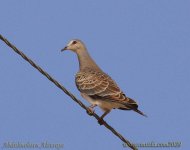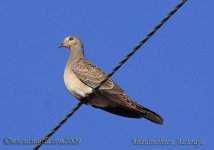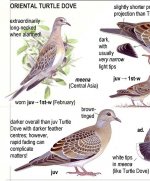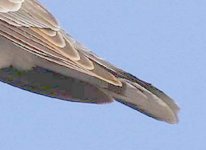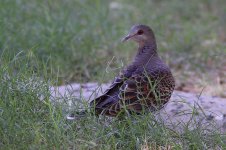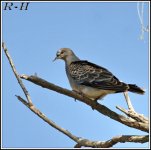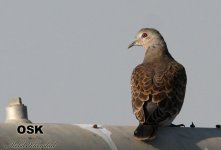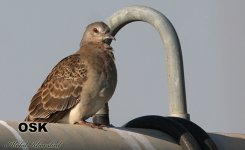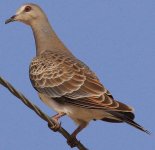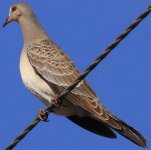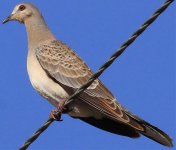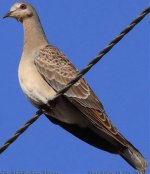-
Welcome to BirdForum, the internet's largest birding community with thousands of members from all over the world. The forums are dedicated to wild birds, birding, binoculars and equipment and all that goes with it.
Please register for an account to take part in the discussions in the forum, post your pictures in the gallery and more.
You are using an out of date browser. It may not display this or other websites correctly.
You should upgrade or use an alternative browser.
You should upgrade or use an alternative browser.
Oriental or European Turtle Dove? From Kuwait (1 Viewer)
- Thread starter alsirhan
- Start date
More options
Who Replied?Joseph N
Lothian Young Birder
Having seen the Turtle Dove that was mis-identified as an Oriental here in Aberdeenshire around a month ago; I must say that is looking much more like an Oriental to me, most likely an orientialis. It looks a lot browner than your standard Eurasian Turtle Dove to me and doesn't have that typical pale grey of the Turtle, so I suggest Oriental. Don't blame me if I am wrong 
Last edited:
tittletattler
Well-known member
I think both birds are European Turtle Dove.
CJW
Hit-and-run WUM
I think both birds are European Turtle Dove.
Agreed.
The Hairy Highlander
Well-known member
I'm going for juv. oriental - the upper fight feathers have more of a dark centre defusely coloured rather than a dark shaft streak and the primaries are dark with a more buffy-brown fringe....
Both photos appear to show the same bird (note the notch on the third outermost primary). I get the impression of European Turtle Dove based on the elongated appearance and the long primary projection (the bird is a bit foreshortened in the first photo). Also the breast looks rather pale, the bill is entirely dark and the black on the outermost rectrix is almost completely restricted to the inner web. The pattern of the primary coverts looks perhaps a bit better for Oriental Turtle Dove, but it's a bit difficult to assess it from these photos.
I agree with CAU that the two photographs are of the same individual, but I believe this is a solid example of a juvenile meena Oriental Turtle Dove. I would say that the tone and pattern of the primary coverts can be much more easily determined in these photographs than is often the case, when they may be largely concealed, or in deep shadow. Both the primary coverts and the primaries are quite black, the former with very narrow and indistinct light tips, a reliable indicator of juv OTD in my experience. While the angle is not ideal for determination of the primary-projection, I think it is on the short side, thereby supporting the identification as OTD. It may not be so characteristic of birds when they are wintering in Northern Europe, but contrary to CAU's impression, I consider the elongate, long-necked look very typical of the (nervous) OTDs I have seen in the Middle East! Judging the relative darkness/lightness of the plumage is very tricky on a lone bird, and the intense light of the Middle East is likely to counter the impression of darkness; in any case, this bird's plumage tones closely match the impressions I have had of meena in Oman, as does its robust looking build, limited bare skin around the large teddy-bear-like eye, and its overall demeanour.
I attach a crop taken from the revised plate in the new second edition Collins Bird Guide, in which I have tried to improve on the not very good treatment of juvenile OTD in the first edition. If it were to transpire that Alsirhan's bird is NOT a juvenile Oriental Turtle Dove it will be back to the drawing board for me! Great photos Alsirhan
Killian Mullarney
I attach a crop taken from the revised plate in the new second edition Collins Bird Guide, in which I have tried to improve on the not very good treatment of juvenile OTD in the first edition. If it were to transpire that Alsirhan's bird is NOT a juvenile Oriental Turtle Dove it will be back to the drawing board for me! Great photos Alsirhan
Killian Mullarney
Attachments
Thanks for your comments, Killian! I have little experience of meena, and I'm not completely certain of how individual features should be weighed, so that's why I wrote that I only get the impression of TD.
I agree that the tips of the primary coverts look indeed good for OTD. Here are some photos taken by Magnus Hellström which also illusrate the difference:
OTD:
http://picasaweb.google.se/stenura/DovesCuckosSandgrousesWoodpeckers#5256715597318027234
TD:
http://picasaweb.google.se/stenura/DovesCuckosSandgrousesWoodpeckers#5256715569717425522
However, Magnus wrote here (unfortunately in Swedish) that it is not a 100% reliable feature:
http://www.artportalen.se/birds/gallery_imageinfo.asp?imageID=103498
Personally I have no idea which way it is.
Here's an Israeli individual, which is considered to be a TD:
http://www.israbirding.com/israelbirdsforum/forum_entry.php?id=871
On a quick glance, the tips of the primary coverts look better for OTD (at least to me), but if you look closer, you can see some brownish hue close to the tip on the first photo, and at least Mats Waern thinks that the tips fit better TD than OTD. If the photos had been a just little smaller or worse perhaps most people would the primary coverts would have looked better for OTD instead (anyway, the difference to the bird on the Kuwaiti photos, where the bird is more distant, isn't great)...
I would agree that the value of the primary projection is debatable, but I wouldn't say that it supports OTD. Here's a Finnish bird identified as a TD for comparison (taken from a similar angle):
http://www.bongariliitto.fi/kuvat/13_Kyyhkylinnut/strtur_20071003_turku_norjy/001_1kv.jpg
Here's a rare comparison photo from Kazakhstan showing both species:
http://www.sofnet.org/apps/image.asp?Path=2&ID=2766&File=Turturduvor.jpg
You're of course correct.
One feature that I also mentioned was the extent of black on the outermost tail feathers. The rightmost tail feather seems to be visible in the second photo (see attachment), and the black colouration is almost completely restricted to the inner web. Here's a photo comparing the tail patterns of both species:
http://picasaweb.google.se/stenura/DovesCuckosSandgrousesWoodpeckers#5256715533996647090
The pattern of the Kuwaiti bird is closer to the TD pictured above, but the black still leaks slightly to the other side of the shaft (which perhaps makes it fit better OTD instead?). I have personally no idea of the variation of either species regarding this feature.
Both the primary coverts and the primaries are quite black, the former with very narrow and indistinct light tips, a reliable indicator of juv OTD in my experience.
I agree that the tips of the primary coverts look indeed good for OTD. Here are some photos taken by Magnus Hellström which also illusrate the difference:
OTD:
http://picasaweb.google.se/stenura/DovesCuckosSandgrousesWoodpeckers#5256715597318027234
TD:
http://picasaweb.google.se/stenura/DovesCuckosSandgrousesWoodpeckers#5256715569717425522
However, Magnus wrote here (unfortunately in Swedish) that it is not a 100% reliable feature:
http://www.artportalen.se/birds/gallery_imageinfo.asp?imageID=103498
Personally I have no idea which way it is.
I would say that the tone and pattern of the primary coverts can be much more easily determined in these photographs than is often the case, when they may be largely concealed, or in deep shadow.
Here's an Israeli individual, which is considered to be a TD:
http://www.israbirding.com/israelbirdsforum/forum_entry.php?id=871
On a quick glance, the tips of the primary coverts look better for OTD (at least to me), but if you look closer, you can see some brownish hue close to the tip on the first photo, and at least Mats Waern thinks that the tips fit better TD than OTD. If the photos had been a just little smaller or worse perhaps most people would the primary coverts would have looked better for OTD instead (anyway, the difference to the bird on the Kuwaiti photos, where the bird is more distant, isn't great)...
While the angle is not ideal for determination of the primary-projection, I think it is on the short side, thereby supporting the identification as OTD.
I would agree that the value of the primary projection is debatable, but I wouldn't say that it supports OTD. Here's a Finnish bird identified as a TD for comparison (taken from a similar angle):
http://www.bongariliitto.fi/kuvat/13_Kyyhkylinnut/strtur_20071003_turku_norjy/001_1kv.jpg
Here's a rare comparison photo from Kazakhstan showing both species:
http://www.sofnet.org/apps/image.asp?Path=2&ID=2766&File=Turturduvor.jpg
Judging the relative darkness/lightness of the plumage is very tricky on a lone bird, and the intense light of the Middle East is likely to counter the impression of darkness;
You're of course correct.
One feature that I also mentioned was the extent of black on the outermost tail feathers. The rightmost tail feather seems to be visible in the second photo (see attachment), and the black colouration is almost completely restricted to the inner web. Here's a photo comparing the tail patterns of both species:
http://picasaweb.google.se/stenura/DovesCuckosSandgrousesWoodpeckers#5256715533996647090
The pattern of the Kuwaiti bird is closer to the TD pictured above, but the black still leaks slightly to the other side of the shaft (which perhaps makes it fit better OTD instead?). I have personally no idea of the variation of either species regarding this feature.
Attachments
Last edited:
Hi CAU,
Thank you very much for your comprehensive and stimulating response. I'm afraid I don't have all the answers, but this discussion, and some of the links you provide are a reminder that the ID of meena vs. some examples of turtur , especially from photographs alone, can be very difficult! Even though this is a subject I have been engaged with for some years, it often feels like for every step 'forwards', there are two steps back! I had already seen the shots of what looks like a turtur in Israel with very limited light tips to the primary coverts so I should have been a little more cautious about placing too much reliance on this feature alone. As for the extent of dark on the outer tail feather, I can see what you are getting at. I have a vague recollection of a short article in British Birds some years ago in which Paul Leader demonstrated how much variation there was in the outer tail feathers of orientalis, including, I think, some with little or no dark bleeding onto the outer web. Unfortunately I just don't have time right now to follow up these interesting lines of enquiry but I hope somebody else does!
If Alsirhan has any more photos of this bird, showing the ouer tail for example, or alongside other doves, they could be very interesting.
Regards,
Killian
Thank you very much for your comprehensive and stimulating response. I'm afraid I don't have all the answers, but this discussion, and some of the links you provide are a reminder that the ID of meena vs. some examples of turtur , especially from photographs alone, can be very difficult! Even though this is a subject I have been engaged with for some years, it often feels like for every step 'forwards', there are two steps back! I had already seen the shots of what looks like a turtur in Israel with very limited light tips to the primary coverts so I should have been a little more cautious about placing too much reliance on this feature alone. As for the extent of dark on the outer tail feather, I can see what you are getting at. I have a vague recollection of a short article in British Birds some years ago in which Paul Leader demonstrated how much variation there was in the outer tail feathers of orientalis, including, I think, some with little or no dark bleeding onto the outer web. Unfortunately I just don't have time right now to follow up these interesting lines of enquiry but I hope somebody else does!
If Alsirhan has any more photos of this bird, showing the ouer tail for example, or alongside other doves, they could be very interesting.
Regards,
Killian
Well, I think that I would now already favour OTD over TD thanks to your replies. My first reply was probably slightly plagued by the fact that I've seen only wintering OTDs in the darkness of Northern Europe, whereas in the desert they should look slimmer and paler.
Here's an OTD with only little black extending to the outer webs of the outermost tail feathers:
http://orientalbirdimages.org/searc...result&Bird_ID=710&Bird_Family_ID=&pagesize=1
Here's an OTD with only little black extending to the outer webs of the outermost tail feathers:
http://orientalbirdimages.org/searc...result&Bird_ID=710&Bird_Family_ID=&pagesize=1
Thanks Killian and CAU,
The photographer Abdulmohsen Alsuraye has asked me for opinion on the bird so I posted these photographs, I asked him for more and larger crops, I will post them when received.
The attached photographs are for OTD that were accepted by KORC the first two were photographed in Nov. 2008 by Mike Pope, Rashed Al-Hajii respectively. The second set on 30/11/2009 by Mohd Khorshed.
In my humble opinion the OTD would show a week shorter bill on average (pale on average) rounded forehead, pale orbital skin only in front of eye if it exists, shorter primary projection (but apparently meena has slightly longer PP than other races of oriental but it is still shorter than ETD), longer tail projection byond primaries. I have seen these features from OBC images from the link below.
Tail of OTD:
http://photo.net/photodb/photo?photo_id=9733185
Photographs of OTD from OBC:
http://orientalbirdimages.org/birdi...rd_ID=710&Bird_Image_ID=537&Bird_Family_ID=91
The photographer Abdulmohsen Alsuraye has asked me for opinion on the bird so I posted these photographs, I asked him for more and larger crops, I will post them when received.
The attached photographs are for OTD that were accepted by KORC the first two were photographed in Nov. 2008 by Mike Pope, Rashed Al-Hajii respectively. The second set on 30/11/2009 by Mohd Khorshed.
In my humble opinion the OTD would show a week shorter bill on average (pale on average) rounded forehead, pale orbital skin only in front of eye if it exists, shorter primary projection (but apparently meena has slightly longer PP than other races of oriental but it is still shorter than ETD), longer tail projection byond primaries. I have seen these features from OBC images from the link below.
Tail of OTD:
http://photo.net/photodb/photo?photo_id=9733185
Photographs of OTD from OBC:
http://orientalbirdimages.org/birdi...rd_ID=710&Bird_Image_ID=537&Bird_Family_ID=91
Attachments
More Crops
With the new set of photographs, it is very clear that these photographs belong to the same bird as first suggested by CAU, the amount of wear on many feathers looks exactly the same.
The amount of bare orbital skin is also very evident in these photographs to support Oriental Turtle Dove, which I think it is OTD.
Many thanks for Killian, CAU, and the others who participated in this thread.
All the best,
Alsirhan
With the new set of photographs, it is very clear that these photographs belong to the same bird as first suggested by CAU, the amount of wear on many feathers looks exactly the same.
The amount of bare orbital skin is also very evident in these photographs to support Oriental Turtle Dove, which I think it is OTD.
Many thanks for Killian, CAU, and the others who participated in this thread.
All the best,
Alsirhan
Attachments
Users who are viewing this thread
Total: 2 (members: 0, guests: 2)




